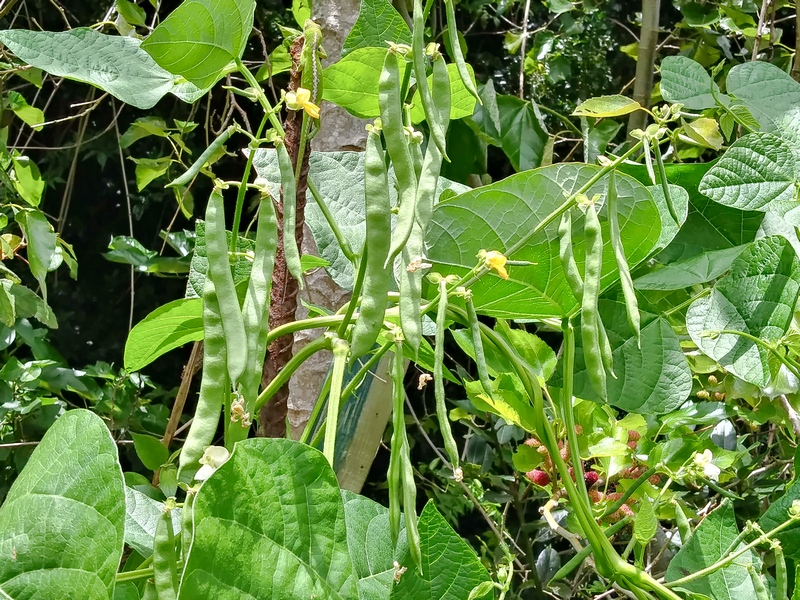Growing season length, and average temperatures.
Although there is "theoretical evidence" to suggest we are moving into "cooler" temperatures,[and shorter growing season] at this point i don't see that backed up by any "real stats".
The discussion on "global warming" ,has become so "political" ,and "agenda orientated" , the information available is unreliable.
The information i see, shows a lengthening of the growing season, [and warmer average temperatures].
I am researching and experimenting with,..high calorie [250 to 500 calories / lb] food plants, that like warmer weather. [Irish potato has "about"347 calories/ lb]
So far, ...
the taro [colocasia esculenta] likes tennessee,and is very productive,and the corms overwintered under a thick mulch.[Taro corms -508 calories / lb]
The taro leaves are a nutrient rich food also. [see link below]
Most taro leaf ,has a long cook time, before it is edible ,IE non irritating to mouth and throat" don't eat taro leaf raw
the Chinese wild yam [dioscorea polystachya]
"about" 450 calories/ lb] 1/2 cup (100 grams), baked with skin: 116 calories, 0 grams fat, 27 grams carbohydrate, 4 grams fibre, 1.5 grams protein, 670 mg potassium, 12 milligrams vitamin C, 0.23 milligrams vitamin B6, .07 milligrams beta-carotene.
Is a weed here, and is very productive. [it is an 'introduced invasive" that was already growing in the yard] This variety seems to have adapted to colder conditions . In my experiments, the "seed" [aerial tubercles] will still grow after being frozen for a month.[an amazing adaptation for this variety]
The Yam, dioscorea rotundata winter killed.
The yam, dioscorea alata winter killed.
Turmeric has over wintered and is productive.[only has 180 calories / lb]
xanthosoma violaceum, is growing very well, i have not tried to "overwinter" it outdoors yet, I now have enough of it to give that a try. [The main value of this plant is for high nutrition ,extremely palatable, steamed, or canned greens]
So far, none of these plants seem to have disease, or insect problems.
Although,... there has been talk by "government agencies" ,of introducing insect pests to attack yam plants. At this point, i don't think this "act of stupidity" has occurred.
The "yam" is a major food plant, that has very few pests in North America.
https://www.thecoconet.tv/coco-talanoa/ ... ro-leaves/
This figure shows the length of the growing season in the contiguous 48 states compared with a long-term average. For each year, the line represents the number of days shorter or longer than average. The line was smoothed using an 11-year moving average. Choosing a different long-term average for comparison would not change the shape of the data over time.
Data source: Kunkel, 20162
Web update: August 2016
Although there is "theoretical evidence" to suggest we are moving into "cooler" temperatures,[and shorter growing season] at this point i don't see that backed up by any "real stats".
The discussion on "global warming" ,has become so "political" ,and "agenda orientated" , the information available is unreliable.
The information i see, shows a lengthening of the growing season, [and warmer average temperatures].
I am researching and experimenting with,..high calorie [250 to 500 calories / lb] food plants, that like warmer weather. [Irish potato has "about"347 calories/ lb]
So far, ...
the taro [colocasia esculenta] likes tennessee,and is very productive,and the corms overwintered under a thick mulch.[Taro corms -508 calories / lb]
The taro leaves are a nutrient rich food also. [see link below]
Most taro leaf ,has a long cook time, before it is edible ,IE non irritating to mouth and throat" don't eat taro leaf raw
the Chinese wild yam [dioscorea polystachya]
"about" 450 calories/ lb] 1/2 cup (100 grams), baked with skin: 116 calories, 0 grams fat, 27 grams carbohydrate, 4 grams fibre, 1.5 grams protein, 670 mg potassium, 12 milligrams vitamin C, 0.23 milligrams vitamin B6, .07 milligrams beta-carotene.
Is a weed here, and is very productive. [it is an 'introduced invasive" that was already growing in the yard] This variety seems to have adapted to colder conditions . In my experiments, the "seed" [aerial tubercles] will still grow after being frozen for a month.[an amazing adaptation for this variety]
The Yam, dioscorea rotundata winter killed.
The yam, dioscorea alata winter killed.
Turmeric has over wintered and is productive.[only has 180 calories / lb]
xanthosoma violaceum, is growing very well, i have not tried to "overwinter" it outdoors yet, I now have enough of it to give that a try. [The main value of this plant is for high nutrition ,extremely palatable, steamed, or canned greens]
So far, none of these plants seem to have disease, or insect problems.
Although,... there has been talk by "government agencies" ,of introducing insect pests to attack yam plants. At this point, i don't think this "act of stupidity" has occurred.
The "yam" is a major food plant, that has very few pests in North America.
https://www.thecoconet.tv/coco-talanoa/ ... ro-leaves/
This figure shows the length of the growing season in the contiguous 48 states compared with a long-term average. For each year, the line represents the number of days shorter or longer than average. The line was smoothed using an 11-year moving average. Choosing a different long-term average for comparison would not change the shape of the data over time.
Data source: Kunkel, 20162
Web update: August 2016























































